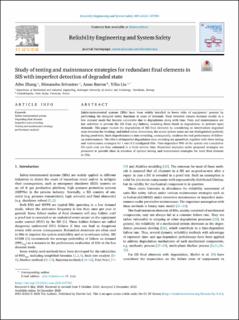| dc.contributor.author | Zhang, Aibo | |
| dc.contributor.author | Srivastav, Himanshu | |
| dc.contributor.author | Barros, Anne | |
| dc.contributor.author | Liu, Yiliu | |
| dc.date.accessioned | 2021-02-09T09:56:16Z | |
| dc.date.available | 2021-02-09T09:56:16Z | |
| dc.date.created | 2021-01-11T09:52:37Z | |
| dc.date.issued | 2021 | |
| dc.identifier.citation | Reliability Engineering & System Safety. 2021, 209 . | en_US |
| dc.identifier.issn | 0951-8320 | |
| dc.identifier.uri | https://hdl.handle.net/11250/2726817 | |
| dc.description.abstract | Safety-instrumented systems (SISs) have been widely installed to lower risks of equipment/ process by performing the designed safety functions in cases of demands. Final elements remain dormant mostly in a low demand mode but become vulnerable due to degradation along with time. Tests and maintenances are key activities to prevent the SIS from any failures, including those thank to degradation, to activate upon demands. This paper models the degradation of SIS final elements by considering an intermediate degraded state between the working- and failed states. Sometimes, the actual system states are not distinguished perfectly during proof tests. Such imperfectness in state revealing, consequently, weakens the real performance of follow-up maintenances. The effects of imperfect degradation state revealing are quantified, together with three testing and maintenance strategies for 1-out-of-2 configured SISs. Time-dependent PFD of the system and cumulative life-cycle cost are then estimated in a finite service time. Numerical examples under proposed strategies are presented to provide clues in selection of optimal testing and maintenance strategies for 1oo2 final element in SISs. | en_US |
| dc.language.iso | eng | en_US |
| dc.publisher | Elsevier | en_US |
| dc.rights | Navngivelse 4.0 Internasjonal | * |
| dc.rights.uri | http://creativecommons.org/licenses/by/4.0/deed.no | * |
| dc.title | Study of testing and maintenance strategies for redundant final element in SIS with imperfect detection of degraded state | en_US |
| dc.type | Journal article | en_US |
| dc.type | Peer reviewed | en_US |
| dc.description.version | publishedVersion | en_US |
| dc.source.pagenumber | 14 | en_US |
| dc.source.volume | 209 | en_US |
| dc.source.journal | Reliability Engineering & System Safety | en_US |
| dc.identifier.doi | 10.1016/j.ress.2020.107393 | |
| dc.identifier.cristin | 1868605 | |
| cristin.ispublished | true | |
| cristin.fulltext | postprint | |
| cristin.fulltext | original | |
| cristin.qualitycode | 2 | |

